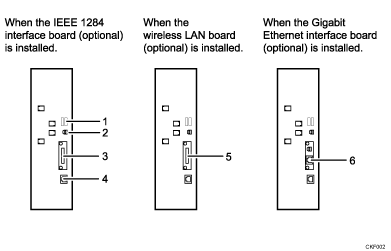This section explains how to identify the machine's interface and connect the machine according to the network environment.
![]()
|

USB Host Interface
Port for connecting a USB interface cable
Use this interface to connect the machine to a card authentication device, external keyboard, or Bluetooth.
USB 2.0 [Type B] port
Port for connecting a USB2.0 [Type B] interface cable
This interface allows the machine to print over USB connection.
IEEE 1284 port (optional)
Port for connecting an IEEE 1284 interface cable
10BASE-T/100BASE-TX port
Port for connecting a 10BASE-T or 100BASE-TX cable
Use this interface to connect the machine to a network.
Wireless LAN port (optional)
Port for using a wireless LAN
Gigabit Ethernet port (optional)
Port for using a 1000BASE-T, 100BASE-TX, or 10BASE-T cable
Use this interface to connect the machine to a network.
![]()
You cannot install the following three options at the same time: IEEE 1284 interface board, wireless LAN board, Gigabit Ethernet board.
The Ethernet port, Gigabit Ethernet port and Wireless LAN interface unit cannot be used simultaneously. If the optional Gigabit Ethernet board is installed, connect the Ethernet cable to the port on the Gigabit Ethernet board. Communication with the machine will fail if cables are connected to both ports simultaneously. If the optional Wireless LAN interface unit is installed, you need to set [LAN Type] to [Wireless LAN] in [Interface Settings] in [System Settings].
The Bluetooth interface unit and the Wireless LAN board cannot be used simultaneously.
